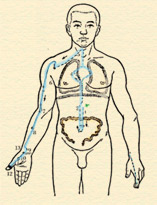Lung and large intestine syndromes
 |
| The lung meridian |
The lungs are situated in the chest. They connect with the throat and open into the nose. Their main physiological functions are dominating qi (vital energy), controlling respiration, maintaining the smoothness of different vessels, and regulating water flow. The skin and hair are important indicators of their health. The lung meridian communicates with the large intestine creating an exterior and interior relationship between these two organs. Thus, they influence each other closely.
The important symptoms of lung diseases are cough, asthma, hemoptysis (spitting blood), and chest pain.
| Lung and large intestine syndromes |
| Syndrome |
Presentations |
Reference with Western medicine |
| Deficiency in lung qi |
Feeble cough, asthma, shortness of breath, which are all worse on exertion, clear and thin sputum, speaking in a low voice, spontaneous sweating, pale and lusterless complexion, fatigue, and aversion to wind and cold. On examination. the tongue is pale with a white coating, and the pulse is deficienct(xu) and forceless. |
Chronic bronchitis |
| Deficiency in lung yin |
Dry cough without sputum or with a little sticky sputum, dry mouth and throat, hoarse voice, skinny appearance, possible cough with bloody sputum, fever occurring at the same time of day, hot sensation in palms and soles, night sweating and flushed cheeks. On examination, the tongue is red with a little coating, and the pulse is thready and rapid. |
Lung tuberculosis |
| Exhausted fluid in large intestine |
Constipation, difficult defecation of dry stools, dry mouth and throat, dizziness and foul breath. On examination, the tongue is red with a yellow dry coating, and the pulse is thready. |
Habitual constipation |
| Wind-cold retention in lung |
Slight aversion to cold, fever, unable to sweating, head and body aches, cough with a thin white sputum, nasal congestion and runny nose. On examination, the tongue coating is thin white, and the pulse is floating and tense. |
Acute upper respiratory infection |
| Wind-heat invading lung |
Cough with yellow and thick sputum, coarse breathing, nasal congestion, thirst, sore throat, headache, fever and slight aversion to wind and cold. The tongue tip is red with a yellow and thin coating, and the pulse is floating and rapid. |
Acute bronchitis, sore throat |
| Dry-heat damaging lung |
Dry cough without sputum, with a little sticky sputum or blood-tinged sputum, dry nose and mouth and sore throat. On examination, the tongue is red and dry with a thin yellow coating, and the pusle is rapid. In serious cases, there may be chest pain when coughing, aversion to cold temperatures, fever or spitting up blood. |
Acute bronchitis, sore throat |
| Phlegm-heat congesting lung |
Cough, asthma, coarse breathing, spitting up turbid yellowish-green sputum, or bloody foul-smelling pus. There may also be thirst, aversion to cold temperatures, fever, chest pain, dark yellow urine and constipation. On examination, the tongue is red with a yellow and greasy coating, and the pulse is rolling and rapid. |
Pneumonia, pulmonary emphysema |
| Phelgm turbidity obstructing lung |
Cough, panting, copious and clear sputum, chest tightness or palpitations, wheezing, and cannot lie flat in severe cases. On examination, the tongue coating is thin and white, and the pulse is rolling. |
Chronic bronchitis |
| Cold fluid stagnating lung |
Cough, panting, copious foamy sputum, cannot lie flat in severe cases, chest tightness, gurgling in throat and an aversion to cold temperatures with symptoms getting worse in cold environments. This syndrome may also be accompanied by an exterior symdromes. On examination, the tongue is white, slimy and greasy, and the pulse is taut and rolling or accompanied with floating. |
Asthmatic bronchitis |
| Damp-heat in large intestine |
Fever, thirst, abdominal pain, loose dark stools with an offensive smell, frequent bowel movements with white and red mucusy stools, burning sensation in the anus, scanty and yellow urine and aversion to cold temperatures. On examination, the tongue is red with a yellow and greasy coating. The pulse is rolling and rapid or hesitant and rapid. |
Acute enteritis, bacterial dysentery |
|